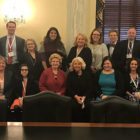
February 22, 2015; Times-Leader (Wilkes-Barre, PA)
If your nonprofit has government contracts, you better hope they take your cash flow seriously. The Wilkes-Barre Times-Leader reports on the impact the cash flow problems of Luzerne County are having on community-based nonprofits in this region, some 100 miles northwest of Philadelphia. It highlights how the Family Service Association of Wyoming Valley has had to rely on a line of credit while waiting for funding to come through from the county for the second consecutive year.
Last year’s county cash crunch cost the agency $8,000 to $9,000 in interest—“monies that could be directed to client services,” points out its executive director. Although he knows the county’s $700,000 payment is coming, he is frustrated with the process, according to the paper.
The money is not a grant, but payment to the $2 million nonprofit on various county contracts to fund programs, including high-risk youth reentry, and family finding and family reunification programs to keep children out of foster care.
Sign up for our free newsletters
Subscribe to NPQ's newsletters to have our top stories delivered directly to your inbox.
By signing up, you agree to our privacy policy and terms of use, and to receive messages from NPQ and our partners.
Every businessperson knows cash flow is critical, but the “cash-strapped county government routinely delays payments to some service providers in the beginning of each year, until tax revenues start filtering in,” says the article. This is not atypical and happens to service providers for governments across the U.S. all the time.
The head of the county’s Department of Budget and Finance told the Times-Leader that he understands the frustration, but says it is unavoidable, primarily for technical reasons. The county doesn’t close out the 2014 fiscal year until the end of February and still has bills from year’s end that have not yet been entered into the system.
Family Services isn’t the only county nonprofit contractor waiting to be paid. Catholic Social Services is owed over $100,000, with the county being six months in arrears. This can make such agencies’ employees nervous, knowing that they are being paid with borrowed money.
Meanwhile, the county is expecting revenue from property tax bills that just went out and has taken out a tax anticipation note, although the bulk of that money is used to pay its own personnel salaries. It doesn’t anticipate being able to reimburse service providers until the bulk of its tax revenues come in, by April 1st.
This small county in northeast Pennsylvania is not the only government agency with a cash flow problem. State and federal governments face similar challenges, and that ripples throughout the system in which much funding is granted down from the federal government to the states and then to localities. Most nonprofit service providers with government contracts already know that a 45-day lag in payments is typical.—Larry Kaplan













